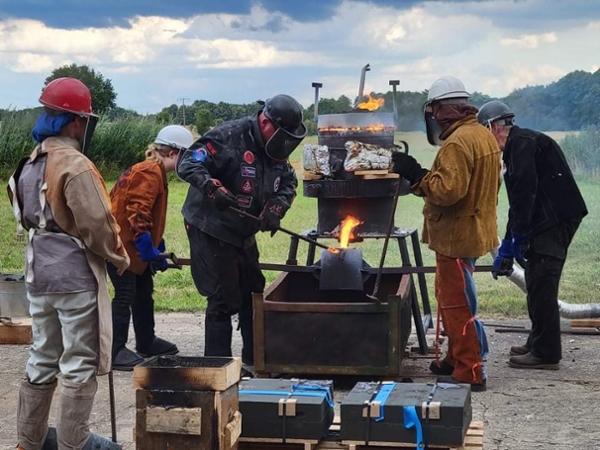LU professor invited to pour iron in Germany
February 22, 2022 | by Natalie Frels-Busby
Lamar University’s Kurt Dyrhaug, professor of sculpture in the Department of Art & Design, has been invited to the Moritzburg Museum in Halle, Germany for its first iron pour in August.
With more than 30 years of experience in coordinating iron pour events for communities and universities, Dyrhaug explained that he was excited when he was contacted by Susanne Roewer.
“I was excited that Susanne organized this opportunity,” he said. “It will be a great opportunity to pour at another location in Germany.”
He explained that he was invited to coordinate in this event due to his relationship with Roewer, whom he has known for a number of years, along with Hans Molberg, who will also be involved in the event. He first met Roewer following the International Symposium on cast metal and 3D printing.
“There were a number of artists from Germany and one from Corpus Christie that also attended, including my daughter (white helmet pouring iron),” Dyrhaug said. “We were a good team and worked well together.”
Dyrhaug attends national and international conferences frequently. He also presents lectures on sculpture, 3D printing and process.
Despite his experience, being chosen to coordinate this event, he said, is an honor.
“It is always an honor to be invited to pour iron in the community, particularly a museum,” Dyrhaug said. “Community members are always excited to watch the melting and pouring process. It’s also great to work with a good group of artists!”
The professor explains the centuries-old process like this: “Unlike bronze, iron requires more BTUs and melts at a higher temperature (2,500 degrees). In the past, charcoal was used as fuel. Coke, a byproduct of coal, has been used in the last 100 years. Artists tend to use smaller furnaces that melt 100-300 pounds every 15-20 minutes. I have worked in an industrial foundry in Houston, Keen Foundry. That furnace melts 2,000 pounds every 15-30 minutes. The smaller the furnace, the smaller the iron needs to be. At Lamar University, we have two furnaces — one melts 100 pounds and the other melts 300 pounds. We break scrap iron into small pieces, approximately 1-2 inches in diameter. Once the iron is melted, it is poured into sand molds and the process is repeated. The sand molds are created by artists in a variety of forms.”
Dyrhaug added, “I enjoy the comradery, working, teaching and learning with other artists. Cast iron sculpture is heavy, hot, magnetic and an exciting medium to work with.”
The community is invited to witness the process from 11:30 a.m. to 2:30 p.m. on March 31, held at the Department of Art & Design foundry.
With more than 30 years of experience in coordinating iron pour events for communities and universities, Dyrhaug explained that he was excited when he was contacted by Susanne Roewer.
“I was excited that Susanne organized this opportunity,” he said. “It will be a great opportunity to pour at another location in Germany.”
He explained that he was invited to coordinate in this event due to his relationship with Roewer, whom he has known for a number of years, along with Hans Molberg, who will also be involved in the event. He first met Roewer following the International Symposium on cast metal and 3D printing.
“There were a number of artists from Germany and one from Corpus Christie that also attended, including my daughter (white helmet pouring iron),” Dyrhaug said. “We were a good team and worked well together.”

Dyrhaug attends national and international conferences frequently. He also presents lectures on sculpture, 3D printing and process.
Despite his experience, being chosen to coordinate this event, he said, is an honor.
“It is always an honor to be invited to pour iron in the community, particularly a museum,” Dyrhaug said. “Community members are always excited to watch the melting and pouring process. It’s also great to work with a good group of artists!”
The professor explains the centuries-old process like this: “Unlike bronze, iron requires more BTUs and melts at a higher temperature (2,500 degrees). In the past, charcoal was used as fuel. Coke, a byproduct of coal, has been used in the last 100 years. Artists tend to use smaller furnaces that melt 100-300 pounds every 15-20 minutes. I have worked in an industrial foundry in Houston, Keen Foundry. That furnace melts 2,000 pounds every 15-30 minutes. The smaller the furnace, the smaller the iron needs to be. At Lamar University, we have two furnaces — one melts 100 pounds and the other melts 300 pounds. We break scrap iron into small pieces, approximately 1-2 inches in diameter. Once the iron is melted, it is poured into sand molds and the process is repeated. The sand molds are created by artists in a variety of forms.”
Dyrhaug added, “I enjoy the comradery, working, teaching and learning with other artists. Cast iron sculpture is heavy, hot, magnetic and an exciting medium to work with.”
The community is invited to witness the process from 11:30 a.m. to 2:30 p.m. on March 31, held at the Department of Art & Design foundry.